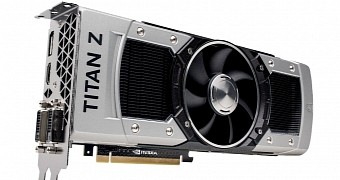It has been months since NVIDIA formally launched the GeForce GTX Titan-Z graphics card, months during which the card's price never faltered from the arguably absurd figure it initially bore. Now, though, this may finally be changing.
The GeForce GTX Titan-Z graphics card has two GK110 graphics processing units arrayed in a dual-chip SLI configuration on the same PCB.
It is the best dual-chip video card on the market, but it loses to AMD's RadeoN R9 295 X2 under certain circumstances. The rest of the time it isn't all that far ahead either.
This has been a big thorn in the side of pretty much every prospective buyer of top-tier graphics, because the AMD board sells for half the price of the Titan-Z. Now, though, this may finally be changing.
Retailers are listing the video card for less than before
If you were to visit Newegg, you might find the graphics card, or at least an OSM version of it, priced at $1,500 / €1,500, which is the tag that AMD's board has had all this time.
This means that NVIDIA is either preparing a Maxwell-based dual-chip monster for release soon, or that the GTX 980 and 970 have upset the market enough to make it necessary.
Considering that you can buy a quad-SLI set of four GeForce GTX 980 video cards for $2,200 / €2,200 while the GTX Titan-Z alone sells for $3,000 / €3,000 (officially), that may very well be the case.
Unfortunately, there is no guarantee that the $1,500 / €1,500 ASUS GTX Titan-Z is not an isolated incident. It appears to be the only cheap listing right now.
More importantly, European stores still hold to the high figure, even though some models seem to have a slightly reduced price here and there. This may be just a decision on the part of OEMs instead of NVIDIA itself.
The specs of the NVIDIA GTX Titan-Z
Just as a reminder, the dual-chip video card has a pair of GK110 chips, leading to a total of 5,760 CUDA cores. Each GPU has a base clock of 705 MHz per GPU, top clock of 876 MHz, and 6 GB of GDDR5 VRAM to work with, making for 12 GB operating at 7 GHz.
The memory interface between the GPU and VRAM is of 768 bits (384 bits per graphics processor) and this all leads to a texture fill rate of 338 billion per second and a memory bandwidth of 672 GB/s, both of them huge levels. If not for the AMD board to compare it with, the price of $3,000 / €3,000 might even have been explainable.

 14 DAY TRIAL //
14 DAY TRIAL //